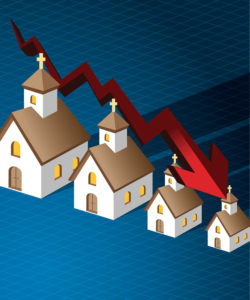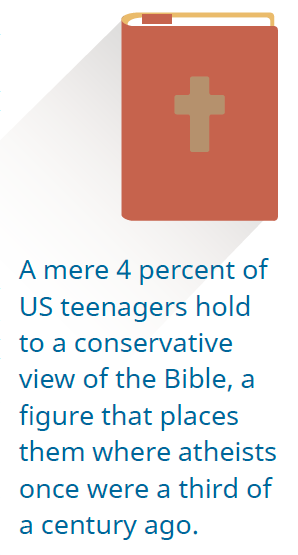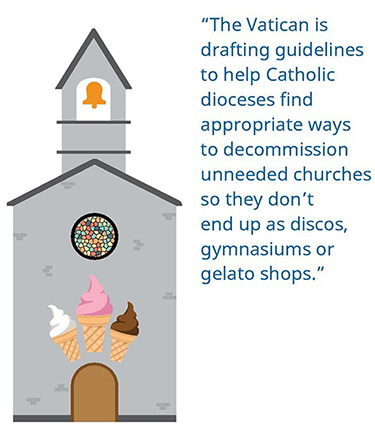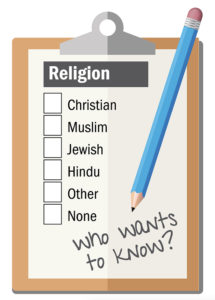Faith and Faithlessness by Generation: The Decline and Rise are Real
 (Image source: Freepik)
(Image source: Freepik) WE’RE REACHING THE END of the alphabet—and the end of a religious statistical oddity in the United States. Generation Z, more so than the preceding Generation Y (the millennials), and even more so than Generation X, is demonstrating a telling and permanent downtrend in religious identity. This is reminiscent of changes that began decades ago in other wealthy nations of the world but that didn’t happen here at the same time.
Western Europeans in particular, under the influence of a long cultural memory of religious wars and in the immediate wake of World War II and its horrors, began a voluntary exodus from the churches. This was aided by a gradual increase in economic and other forms of security (which are known to reduce dependence on the hopeful magical thinking of faith), made possible through Europe’s adoption of social democratic forms of government dedicated to advancing social rights (such as the right to medical care) along with individual liberties. Beyond this, European governments engaged in the practice of funding state churches, which managed to satisfy these churches politically as well as sap their proselytizing zeal. Meanwhile Eastern Europeans were brought under the influence of Soviet communism, which acted to ensure that whole generations of children would be reared in a secular environment that discouraged religious faith. Between these two developments, secularism eventually became the norm across most of Europe. And the influence of this revolution spread to Europe’s English-speaking former colonies of Canada, Australia, and New Zealand.
The United States, however, was different. Here was a nation established partially by religious minorities and refugees, yet one that was also founded on the idea that government should neither fund nor interfere with religion. These factors, combined with a commitment to free enterprise, led to religious diversity and religious enterprise. The churches competed against each other, not with warfare but as independent businesses vying for market share. Such competition gave religion in this country a vitality and variety unparalleled elsewhere. Moreover, because of a constitutional focus on individual liberties without an equal commitment to social rights, citizens had more opportunity to succeed—or fail. And this fostered a level of insecurity that further drove the population toward faith. As a result, the United States became the exception to the rule that industrialization, prosperity, and modernity inevitably lead to a reduction in religious belief.
 Still, it was only a matter of time before even the United States would gradually lose its religiosity. Religions founded on Bronze Age and medieval understandings of the world are limited in how many belief-upending scientific discoveries they can adjust to before adherents find the constant conflict exhausting. Moreover, the technologies that spin off of science don’t just make for new conveniences, they disrupt religion’s dictated lifestyles. Consider the social transformations spawned by the birth control pill and the information revolution, to name only two.
Still, it was only a matter of time before even the United States would gradually lose its religiosity. Religions founded on Bronze Age and medieval understandings of the world are limited in how many belief-upending scientific discoveries they can adjust to before adherents find the constant conflict exhausting. Moreover, the technologies that spin off of science don’t just make for new conveniences, they disrupt religion’s dictated lifestyles. Consider the social transformations spawned by the birth control pill and the information revolution, to name only two.
To understand how the groundwork was laid for changes in American religious identity, it is necessary to follow the progression of generations. The story begins with the post-World War II baby boom. That large contingent of children born from 1946 through 1964 are called the baby boomers, most of whom came of age during the turbulent 1960s, which included the Civil Rights movement, the unpopular Vietnam War, and the assassinations of President John F. Kennedy and Martin Luther King Jr. These experiences led to a questioning of established institutions that was countered only by good economic opportunities in that era that built optimism for the future.
Those of the second half of the baby boom were born from 1955 through 1964 and came of age mostly during the ’70s. This was the era bounded by Watergate at the front end and the Oil Embargo at the back, immediately followed by the AIDS crisis. As a result, members of this cohort went from questioning institutions to mistrusting them. And they began turning away from traditional religious organizations toward the individualized programs of self-help psychology that soon had them branded as the “me” generation.
Such independent mindedness affected what followed: Generation X, sometimes called the “MTV generation.” Born from 1965 through 1980, Gen Xers were more often placed in daycare as children, became the stereotyped “latchkey kids” of parents with careers outside the home, and experienced a larger incidence of family divorce. Coming of age starting in the mid-1980s, they tended to drop out of political and religious life and exercise more caution about forming families. Today they are middle-aged.
Generation Y is called the Millennial Generation because its members first started coming of age around 2000. Many in this cohort are the children of boomers who waited before starting families.
Today it is Generation Z (the “iGeneration”) that is beginning to come of age, after having grown up in what has been called a post-Christian and postmodern environment. Given that many of their parents, whether believers or not, didn’t go to church or send their children there, many in this generation haven’t been exposed to Christianity or other religions. As Brooke Hempell, senior vice president of research for the Barna Group, said to the Christian Post in January of this year, “There are a lot of churches that are empty in this country. Gen Z is the one who is really showing the fruit of that.”
This emptying of the churches is a very real phenomenon in the United States. A July 8, 2018, article in the Minneapolis Star Tribune reported on “the unchurching of America,” declaring that
Steep drops in church attendance, aging congregations, and cultural shifts away from organized religion have left most of Minnesota’s mainline Christian denominations facing unprecedented declines… The rising toll is evident in rural, urban and suburban churches across the state.
 Specifically, since the year 2000 about 150 of Minnesota’s churches belonging to the Evangelical Lutheran Church in America have had to close their doors. Of the remaining 1,050 churches in that denomination, a third have fewer than fifty members, according to the Star Tribune.
The total membership loss is nearly 200,000. Over the same period, sixty-five of Minnesota’s United Methodist churches have closed. Meanwhile Roman Catholic churches in the state that numbered 720 in 2000 have since dropped to 639.
Specifically, since the year 2000 about 150 of Minnesota’s churches belonging to the Evangelical Lutheran Church in America have had to close their doors. Of the remaining 1,050 churches in that denomination, a third have fewer than fifty members, according to the Star Tribune.
The total membership loss is nearly 200,000. Over the same period, sixty-five of Minnesota’s United Methodist churches have closed. Meanwhile Roman Catholic churches in the state that numbered 720 in 2000 have since dropped to 639.
What’s true for Minnesota is true for the nation as a whole. “Since 1990, the Episcopal Church, the Presbyterian Church USA, and United Church of Christ have lost nearly half their national members,” the Star Tribune article notes. The Evangelical Lutheran Church of America has lost a third.
The Roman Catholic Church, while claiming ongoing membership growth, acknowledges a loss of 2,000 parishes in the United States, a situation repeated in dioceses in Europe and Australia. Because of this, according to an Associated Press report of July 10, 2018, “the Vatican is drafting guidelines to help Catholic dioceses find appropriate ways to decommission unneeded churches so they don’t end up as discos, gymnasiums or gelato shops.” This will be followed in November by an international conference for Catholic leaders on how to manage the sale of church property and handle church assets as well as how to foster the repurposing of closed or sold churches as cultural centers, bookstores, libraries, or other alternatives considered acceptable. The Vatican’s culture minister, Cardinal Gianfranco Ravasi, sees these moves as necessary because of a drop in the number of Catholics who still go to church and a rise in the secularization of society.
Projecting into the future, Scott Thumma, director of the Hartford Institute for Religion Research, predicts, “In the next twenty years, you’ll have half as many open congregations as now.” This is in part because those members remaining in the pews are getting older. According to the Pew Research Center, the median age is over fifty for congregants in almost all mainline Protestant denominations in the United States and forty-nine for Roman Catholics.
But what about the conservative evangelical churches? Liberal and mainline churches were only the first to experience serious membership losses. And this led many to believe that stricter and more demanding denominations, like the Southern Baptists, had found the secret to religious success. But the decline in American religious observance is now affecting them too.
In 2017 the Public Religion Research Institute reported that only 43 percent of the US population was made up of white Christians, down from 80 percent four decades ago, and only 17 percent of those white Christians were evangelicals, down from 23 percent in 2007. While these figures reflect a relative growth in the percentage of nonwhite Christians, they also reflect an overall reduction in religious identity. According to the Religion News Service, citing data from LifeWay, “The Southern Baptists have lost more than a million members over the last decade.” And this applies to church membership, church attendance, and financial support. Meanwhile the growth of the Mormon Church, once the envy of the other denominations, is now barely keeping pace with the growth of the US population.
The pace of this decline will only quicken in the years ahead now that Generation Z has established itself as the most non-Christian in US history. This is easy to see when making comparisons over time. In 1986, for example, 10 percent of young adults (ages eighteen to twenty-nine) gave the answer “none” to a PRRI survey asking their religion. In 2016 that the figure had shot up to 39 percent.
While not all “nones” are atheists, 13 percent of Generation Z clearly identify as such compared to 7 percent of the older Generation X, which itself was about double that of boomers. So the effect across the generations has been cumulative. Moreover, this past January the Barna Group found that a mere 4 percent of US teenagers held to a conservative view of the Bible, a figure that places them where atheists once were a third of a century ago.
Yet these numbers for young atheists are now considered too low because there are always respondents who aren’t up front with pollsters about their atheism. One indicator is another PRRI survey in 2016 that discovered that one-third of atheists had hidden their views from friends and family. Furthermore, it’s well established that respondents to polls tend to overreport their religious observance and are often reticent to admit when they don’t observe at all.
Another kind of religious overreporting comes from questions that are too vague. A recent Gallup poll with a simple yes-or-no question on the subject of belief found that 89 percent of Americans are theistic. But when this question was clarified in a different poll to specify an anthropomorphic god, theistic belief stood at only 53 percent. Then there is the question of doubt among believers. PRRI polled for this and recorded that “27 percent of the public—including nearly 40 percent of young adults—said they sometimes have doubts about the existence of God.”
The biggest discovery, however, came out in a University of Kentucky study done in 2017, which got around the usual polling problems by asking the God question indirectly. A random sampling of 4,000 US adults were divided into two groups, given a list of nine innocuous statements (such as “I own a dog”), and asked to indicate how many of them were true. But the experimental group had a tenth statement inserted into the mix: “I do not believe in God.” With this difference the experimenters were able to compare the totals of the two groups to determine the likely number of nonbelievers in the United States. The figure they arrived at was 26 percent.
Another way of getting around the tendency of many atheists to hide their atheism is to ask Americans in general how many atheists they know. On this matter the Pew Forum reported in 2017 that 60 percent said they knew an atheist. That figure was less than 50 percent ten years ago. One can also make a comparison: among young adults today, more report knowing an atheist than knowing an evangelical Christian.
 Finally, there is the historic indicator of rising secularism that can be found in lowered birthrates. Secularized parts of the world, like Europe, chart lower fertility rates when compared to places with high religiosity, like most of Africa, which charts high fertility rates. This was addressed in a June blog post by Professor Philip Jenkins of Baylor University’s Institute for Studies of Religion. He declared that the United States is “looking at the opening stages of a large scale process of secularization.” Starting in 2010, the US fertility rate dropped below 2.0 and hasn’t gone back up. In 2016 it was down to 1.74, which Jenkins calls “a very European rate.” This means that instead of being different from Europe, the United States is on the same secularizing track, being merely “a laggard, not an exception.”
Finally, there is the historic indicator of rising secularism that can be found in lowered birthrates. Secularized parts of the world, like Europe, chart lower fertility rates when compared to places with high religiosity, like most of Africa, which charts high fertility rates. This was addressed in a June blog post by Professor Philip Jenkins of Baylor University’s Institute for Studies of Religion. He declared that the United States is “looking at the opening stages of a large scale process of secularization.” Starting in 2010, the US fertility rate dropped below 2.0 and hasn’t gone back up. In 2016 it was down to 1.74, which Jenkins calls “a very European rate.” This means that instead of being different from Europe, the United States is on the same secularizing track, being merely “a laggard, not an exception.”
All of this goes hand in hand with the rise of organizations in the secular movement. For example, in the 1980s there were only six prominent national secularist organizations in the United States: American Atheists, the American Ethical Union, the American Humanist Association, the Council for Secular Humanism, the Freedom From Religion Foundation, and the Society for Humanistic Judaism. But starting in 2006 with the rise of the “new atheism,” the number of national, local, and special interest organizations in the movement exploded. And the number keeps expanding, as one can easily see by paying a visit to the Secular Directory online.
These changes have been noticed with alarm on the Far Right. Not only do evangelicals lament and try to address these changes at their annual conventions, they’ve become more vigorous politically in an effort to roll back the tide. The latest example of this is Project Blitz, a campaign launched by the Congressional Prayer Caucus Foundation that, for starters, aims to place the national motto, “In God We Trust,” in every public school in the nation. Already this year five state legislatures have passed laws requiring this in their schools: Alabama, Arizona, Florida, Louisiana, and Tennessee. Arkansas mandated this in 2017. More symbolic efforts of this sort, as well as substantive challenges to the Jeffersonian “wall of separation” between church and state, can be expected. And current changes in the makeup of the US Supreme Court will make resistance to this evangelical backlash more difficult.
Social change often brings such upheavals as nations and cultures struggle to absorb or adjust to transformations in the status quo. Bob Dylan originally sang “The Times They Are a-Changin’” to the baby boomers, but that anthem rings just as true today.
